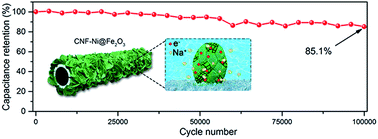Interface metallization enabled an ultra-stable Fe2O3 hierarchical anode for pseudocapacitors†
Abstract
Despite significant advances in cathode materials, developing high-performance anodes remains a key challenge for future pseudocapacitors. Fe2O3 has been considered as a promising anode candidate due to its high theoretical capacitance, environmental benignity, and earth-abundant characteristics. However, the low electronic conductivity and poor cyclability of Fe2O3 significantly limit its practical application. In this work, a 3D nickel-metalized carbon nanofiber network was developed to deposit an Fe2O3 nanosheet anode. The nickel layer not only improved the electronic conductivity and the wettability of the 3D carbon substrate but also benefit the stability of the Fe2O3/carbon interfaces and the stress-release upon cycling. As a result, the newly designed Fe2O3 anode composite exhibited a high areal capacitance of 1.80 F cm−2 at a high mass loading of 4.2 mg cm−1 and ultra-high capacitance retention of 85.1% after successive 100 000 cycles, outperformed most of the reported Fe2O3-based anode materials. Extended the interface metallization method to a MnO2 cathode, excellent capacitance retention of 108.2% was reached after 26 000 cycles, suggesting a potentially broad application of such an interface-management method in elevating the stability of metal oxide materials in various pseudocapacitive energy storage devices.



 Please wait while we load your content...
Please wait while we load your content...